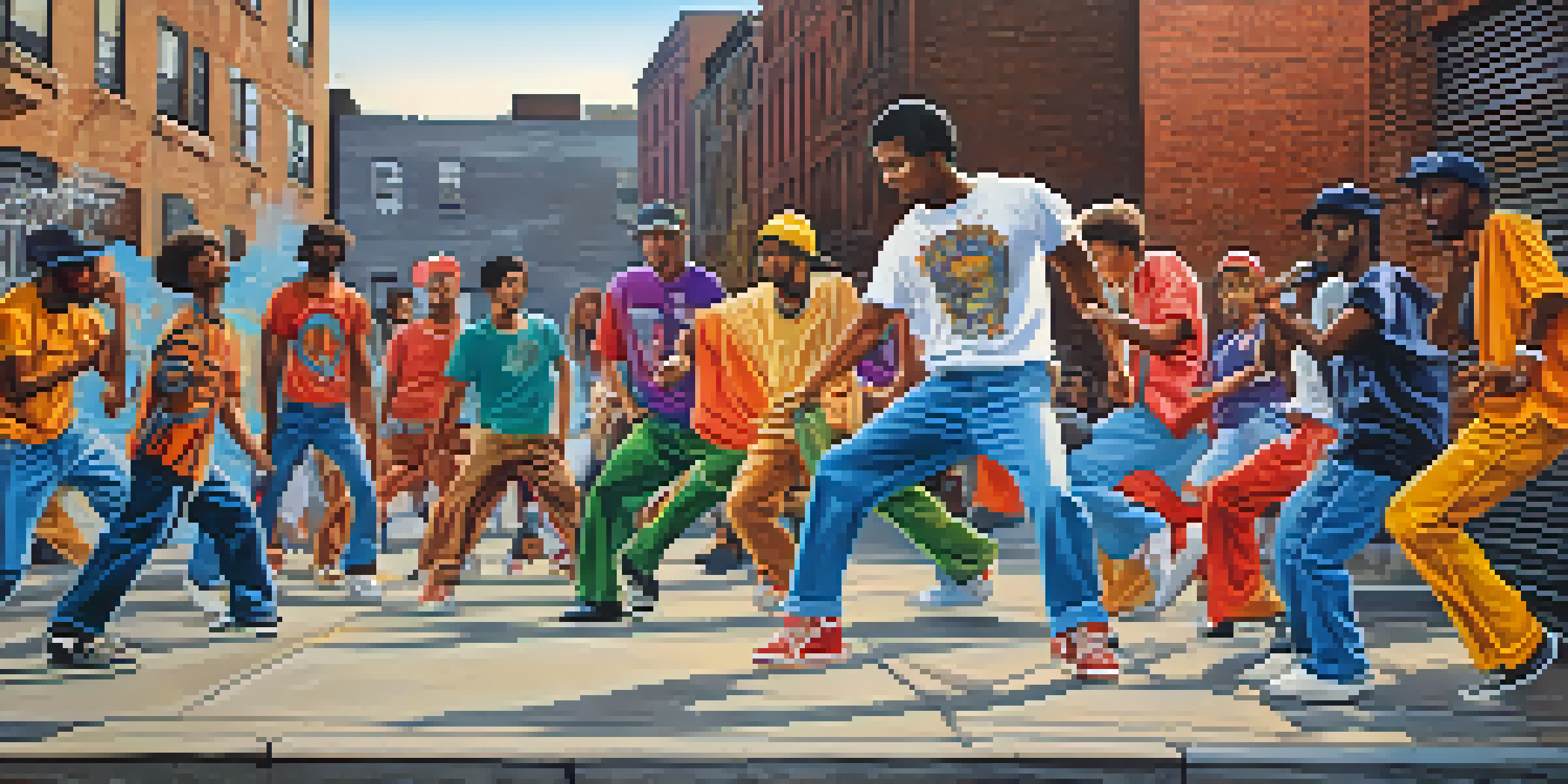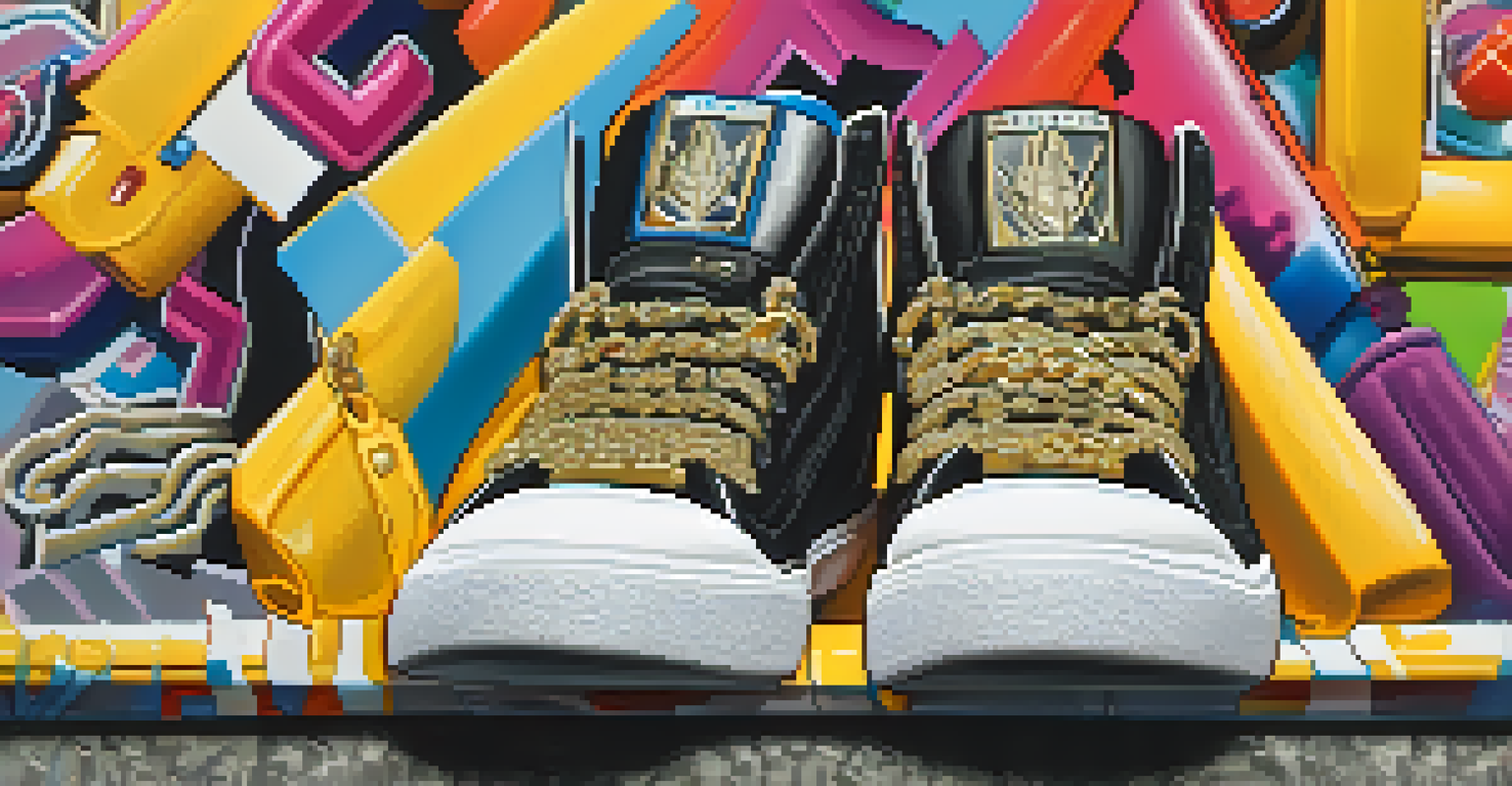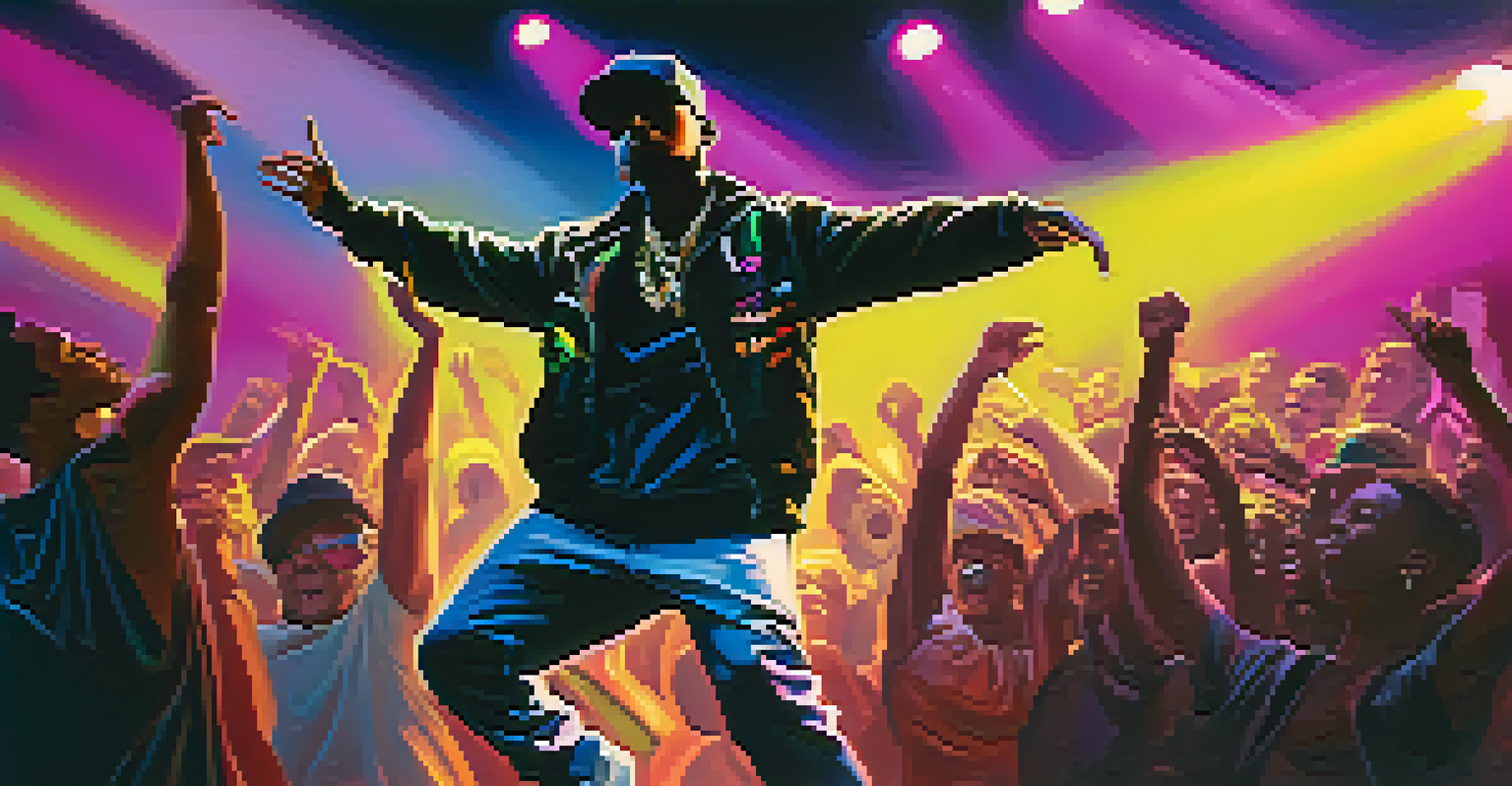The Influence of Hip-Hop on Streetwear and Urban Fashion

The Roots of Hip-Hop and Its Fashion Connection
Hip-hop emerged in the 1970s in the Bronx, intertwining music, dance, and visual art. This cultural movement also sparked a unique fashion style that was raw, expressive, and reflective of the urban experience. Artists and dancers became trendsetters, showcasing their individuality through clothing choices that often included oversized fits and bold colors.
Fashion is a way to say who you are without having to speak.
The connection between hip-hop and fashion became even more pronounced as artists like Run-DMC and LL Cool J began sporting labels like Adidas and Kangol. Their influence not only popularized these brands but also established a new standard for streetwear. This synergy created a powerful relationship where music and fashion thrived together, shaping a distinct urban identity.
As hip-hop grew, so did its impact on streetwear, which began to attract attention from mainstream fashion. This shift marked the beginning of a new era where urban aesthetics influenced high-end designers, creating a vibrant blend of street culture and luxury fashion.
Key Elements of Hip-Hop Style in Streetwear
Hip-hop fashion is characterized by specific elements: baggy jeans, graphic tees, and flashy sneakers. These items speak to comfort and self-expression, allowing individuals to showcase their personality and cultural identity. Accessories like snapback hats, gold chains, and oversized sunglasses also play a significant role in completing the look.

The use of bold graphics and logos has become synonymous with hip-hop style, often reflecting social themes or personal stories. Brands like Supreme and Off-White exemplify this trend, merging art and fashion to create wearable statements. This emphasis on graphics not only attracts attention but also fosters a sense of community among fans of the culture.
Hip-Hop Shapes Fashion Trends
The fusion of hip-hop and fashion has created a dynamic style that influences both streetwear and high-end designers.
Moreover, the influence of hip-hop on streetwear can be seen in the rise of collaborations between artists and fashion brands. These partnerships allow for innovative designs that resonate with fans, further blurring the lines between music and fashion while promoting inclusivity and diversity.
The Role of Social Media in Hip-Hop Fashion
In today's digital age, social media plays a crucial role in shaping fashion trends. Platforms like Instagram and TikTok allow hip-hop artists and influencers to showcase their style to millions of followers instantly. This visibility amplifies fashion choices, making them more accessible and desirable to a broader audience.
Hip-hop is the only genre that can make you feel like you’re part of something bigger than yourself.
Artists like Cardi B and Travis Scott have leveraged their social media presence to influence streetwear trends, often sharing their outfits and collaborations. This direct interaction with fans fosters a sense of connection, turning followers into active participants in the fashion conversation. As a result, trends can spread rapidly, with styles going from the streets to mainstream in record time.
Additionally, social media has birthed an era of 'fit pics' and fashion challenges, encouraging users to recreate iconic looks. This phenomenon not only democratizes fashion but also highlights the power of hip-hop culture in driving contemporary style narratives.
Streetwear Brands Influenced by Hip-Hop Culture
Several streetwear brands have deep roots in hip-hop culture, with names like A Bathing Ape (BAPE) and Stüssy standing out. BAPE, founded in Japan, gained popularity through its unique designs and collaborations with hip-hop artists. This brand exemplifies how streetwear can transcend borders while maintaining its hip-hop essence.
Another notable brand, Fear of God, founded by Jerry Lorenzo, has made waves in both urban and high-fashion circles. The brand's aesthetic often draws inspiration from hip-hop, featuring oversized silhouettes and neutral palettes. The crossover appeal speaks to a growing trend where hip-hop influences not only dictate streetwear but also challenge traditional fashion norms.
Social Media Amplifies Style
Platforms like Instagram and TikTok enable artists to showcase their fashion choices, making trends more accessible and rapidly spreading them.
Furthermore, the emergence of smaller, independent brands that cater to specific subcultures within hip-hop showcases the diversity of the style. These brands often prioritize authenticity and community engagement, ensuring that the spirit of hip-hop remains at the forefront of their designs.
The Impact of Hip-Hop Icons on Fashion Trends
Hip-hop icons have long served as fashion role models, influencing generations with their unique styles. Figures like Kanye West, Rihanna, and Jay-Z have not only made music but have also become fashion moguls in their own right. Their collaborations with major brands have transformed the way streetwear is perceived in the fashion industry.
Kanye's Yeezy line, for instance, has revolutionized sneaker culture, merging minimalism with hip-hop flair. This blend of aesthetics has garnered a massive following, proving that hip-hop's influence can extend beyond music into the realm of high fashion. Similarly, Rihanna's Fenty line has broken barriers by emphasizing inclusivity and diversity in fashion, reflecting the values of the hip-hop community.
These icons exemplify how personal style can shape trends, encouraging fans to adopt and adapt their looks. As they continue to push the boundaries of fashion, the connection between hip-hop and streetwear only grows stronger, inspiring the next wave of artists and designers.
The Evolution of Urban Fashion Through Hip-Hop
Urban fashion has evolved significantly alongside hip-hop, reflecting the socio-political landscape of each era. In the 90s, baggy pants and oversized jackets dominated, symbolizing a break from traditional norms. This era's fashion choices were often a response to societal issues, with artists using their platforms to address inequality and racial injustice.
As hip-hop progressed into the 2000s, so did the style, with a shift towards more polished looks that incorporated elements of luxury. The blending of high fashion with streetwear became increasingly prevalent, with brands like Gucci and Balenciaga tapping into hip-hop culture for inspiration. This evolution highlights how urban fashion is continuously shaped by the voices and experiences of the artists within the community.
Icons Drive Fashion Evolution
Hip-hop icons like Kanye West and Rihanna not only set trends but also redefine the boundaries of fashion through innovative collaborations.
Today, we see a fusion of styles that embraces both heritage and innovation, with streetwear now recognized on global runways. This trajectory showcases the power of hip-hop in redefining what urban fashion can be, proving that it is not just a passing trend but a lasting influence that will continue to evolve.
The Future of Hip-Hop and Streetwear Collaboration
Looking ahead, the collaboration between hip-hop and streetwear shows no signs of slowing down. As new artists emerge, they bring fresh perspectives that challenge conventional fashion norms. This continuous evolution promises to keep the dialogue between music and fashion vibrant and relevant.
Moreover, the increasing emphasis on sustainability within the fashion industry is likely to impact future streetwear designs. Hip-hop artists are becoming more vocal about environmental issues, advocating for responsible fashion practices. This shift not only enhances the credibility of the culture but also encourages fans to make conscious choices in their fashion consumption.

Ultimately, the future of hip-hop and streetwear will likely be marked by innovation, inclusivity, and a commitment to social change. As these elements intertwine, they will continue to redefine urban fashion, ensuring that hip-hop's influence remains a staple in the fashion world.